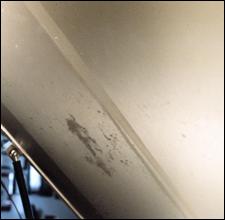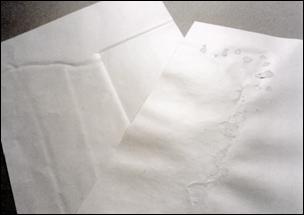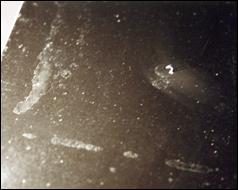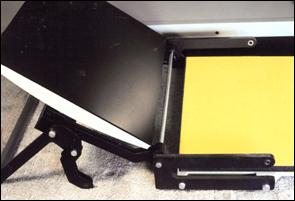 Photo 1
Photo 1
Vacuum platen has adhesive along left side which must be removed.
Routine maintenance and understanding of your equipment is essential when dry mounting in order the keep things running smoothly. The platen should be visually checked daily/weekly/monthly—depending on use—for adhesive residue and should be wiped with a lint free microfiber rag to remove dust, dirt and particles prior to each day's use (photo 1). Particles and/or residue can embed its pattern into soft surface substrates such as foam center board and with HA boards fast becoming the dry mount adhesive/substrate of choice it is becoming more important than ever to work with clean equipment.
 Photo 1
Photo 1
Vacuum platen has adhesive along left side which must be removed.
Vacuum Presses
Each day after the vacuum press has been heated—but prior to first mounting—the press should be run through one full four minute cycle with all regular release materials but no project. This will pull any moisture from within the press in preparation for the day's mounting projects. At the end of all press use each day, prior to shutting down, run one last four minute cycle with the lid fully open to draw air through the system clearing hoses of any moisture build-up during use that day. This procedure should be part of the routine of every manufacturer and model hot vacuum press. Excessive creases and indentations from multiple substrates can also transfer to new substrate surfaces (photo 2).
 Photo 2
Photo 2
Paper (L) shows badly dented sheet, (R) the silicone has been damaged by water moisture.
Mechanical Press Adjustments
As with vacuum systems, the release material of choice must be routinely checked for residue and damage (photo 3). For the press itself develop a routine of wiping down the inside of your press platen with a clean, soft, lint-free rag to remove bits of unwanted adhesive and dust prior to each use, and keep the press closed—but not locked—when not in use to avoid dust and pollution contamination. Nightly covering—as you should with your mat cutter—also helps avoid dust and contamination.
 Photo 3
Photo 3
Adhesive on platen of mechanical press.
Light adhesive buildup on a mechanical press platen can be partially removed by heating a press to 200ºF, and turning it off with a piece of clean Kraft paper clamped closed inside overnight. As the press cools most of the adhesive should transfer to the paper. Remove the paper and discard in the morning. If additional cleaning is necessary the press can be unhinged and laid open (photo 4), then apply cream platen cleaner (available from framing distributors) to the cold press and scrub with a nonabrasive pad to remove residue. Open windows for ventilation when working, and never use blades or sandpaper that could scratch the platen surface.
 Photo 4
Photo 4
Press can be unhinged and opened like a book for easy cleaning.
Release Materials
All release materials should be retired every fifty working hours. It is ill-advised to ever use a release board on the bottom of a vacuum press mounting package. The silicone coating can suction to the platen not allowing the air to be compressed from between the layers resulting in immediate or future bubbles. It also prevents the rubber diaphragm from conforming around the edges of the substrate which is designed to give even pressure against the heat source during bonding.
Release boards may be used on top of mounting projects but are never required in a vacuum unit. Occasionally a rigid board stiffener may be needed beneath a project with no substrate as when pre-mounting an adhesive or canvas transferring, but use a non-silicone scuff board just a little larger than the project.
END
Copyright © 2014 Chris A Paschke
There is a special section in the library for all past issues of Pacific Southwest PPFA Chapter, PS Framer.
For more articles on mounting basics look under the mounting section in Articles by Subject.
Additional information on all types of mounting is found in:
The Mounting and Laminating Handbook, Second Edition, 2002,
The Mounting And Laminating Handbook, Third Edition, 2008 and
Creative Mounting, Wrapping, And Laminating, 2000 will teach you everything you need to know about getting the most from your dry mount equipment and materials as an innovative frame designer.
All books are available from Designs Ink Publishing through this website.
Chris A Paschke, CPF GCF
Designs Ink
Designs Ink Publishing
785 Tucker Road, Suite G-183
Tehachapi, CA 93561
P 661-821-2188
chris@designsinkart.com